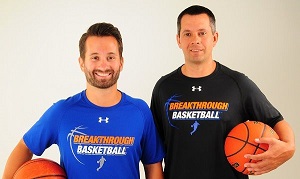How Ku Basketball Won the Schedule Again
The rules of basketball, thankfully, are fairly straightforward.
Still, if you�re coaching younger players, these rules tin be easily forgotten once they have the flooring.
The 3-second dominion (which we�ll discuss later in this article) is merely one of many great examples.
But earlier y'all can teach the rules to your squad, y'all must know them yourself.
And so go on reading, because by the end of this article, you�ll be up to speed on all the basketball rules so y'all tin teach your players and help them develop throughout the season!
The Rules
Basketball is a team sport.
Two teams of five players each effort to score by shooting a ball through a hoop elevated 10 feet above the basis.
The game is played on a rectangular flooring called the court, and there is a hoop at each terminate.
The court is divided into 2 principal sections past the mid-court line.
If the offensive team puts the brawl into play behind the mid-court line, it has ten seconds to get the ball over the mid-court line.
If it doesn't, then the defense gets the ball.
Once the offensive team gets the brawl over the mid-court line, it tin no longer accept possession of the ball in the area behind the midcourt line.
If information technology does, the defense is awarded the ball.

Basketball Court 1
The brawl is moved down the court toward the basket by passing or dribbling. The team with the ball is chosen the offense. The team without the brawl is called the defense.
The defense tries to steal the brawl, competition shots, deflect passes, and garner rebounds.
Points
When a team makes a basket, they score two points and the ball goes to the other team.
If a basket, or field goal, is made outside of the three-bespeak arc, then that basket is worth three points. A free throw is worth 1 point.
Free throws are awarded to a team co-ordinate to some formats involving the number of fouls committed in a half and/or the blazon of foul committed.
Fouling a shooter always results in two or three complimentary throws being awarded the shooter, depending upon where he was when he shot. If he was beyond the iii-point line, then he gets three shots.
Other types of fouls do not upshot in free throws being awarded until a sure number have accumulated during a half (called �squad fouls�).
Once that number is reached, so the player who was fouled is awarded a '1-and-1' opportunity. If he makes his commencement free throw, he gets to attempt a 2d. If he misses the beginning shot, the ball is alive on the rebound.
Game Clock
Each game is divided into sections, and all levels have two halves.
In college, each half is xx minutes long.
In high schoolhouse and below, the halves are divided into eight (and sometimes, six) minute quarters. In the pros, quarters are twelve minutes long.
At that place is a gap of several minutes between halves. Gaps between quarters are relatively brusk.
If the score is tied at the terminate of regulation, then overtime periods of diverse lengths are played until a winner emerges.
Basket Assignment and Tip-Off
Also, each team is assigned a handbasket or goal to defend.
This means that the other basket is their scoring basket.
At halftime, the teams switch goals.
The game begins with one player from either squad at center court.
A referee will toss the brawl upwards between the two. The player that gets his hands on the ball volition tip it to a teammate. This is called a tip-off.
(Notation: Looking for a simple program you can follow with your youth team? Or only some additional drills and plays to keep your players engaged and ready them upward for success? Check out our FREE 72 Winning Youth Drills and Plays eBooks to help your players develop AND have fun doing it.)

Fouls and Violations
In addition to stealing the ball from an opposing player, there are other ways for a squad to get the ball.
1 such way is if the other team commits a foul or violation.
FOULS
Personal fouls: Personal fouls include whatever type of illegal physical contact.
- Hitting
- Pushing
- Slapping
- Holding
- Illegal choice/screen -- when an offensive histrion is moving. When an offensive thespian sticks out a limb and makes physical contact with a defender in an endeavor to block the path of the defender.
Personal foul penalties: If a player is shooting while a being fouled, then he gets two free throws if his shot doesn't become in, but only one free throw if his shot does go in.
- Three free throws are awarded if the player is fouled while shooting for a three-point goal and they miss their shot. If a histrion is fouled while shooting a 3-point shot and makes it anyway, he is awarded one free throw. Thus, he could score four points on the play.
- Inbounds. If fouled while not shooting, the brawl is given to the team the foul was committed upon. They get the ball at the nearest side or baseline, out of bounds, and accept five seconds to pass the ball onto the court.
- One & one. If the squad committing the foul has seven or more fouls in the game, and then the histrion who was fouled is awarded one free throw. If he makes his first shot, then he is awarded another free throw.
- X or more fouls. If the team committing the foul has 10 or more fouls, then the fouled player receives two gratuitous throws.
Charging. An offensive foul that is committed when a role player pushes or runs over a defensive actor. The ball is given to the squad that the foul was committed upon.
Blocking. Blocking is illegal personal contact resulting from a defender not establishing position in fourth dimension to prevent an opponent'southward bulldoze to the basket.
Flagrant foul. Violent contact with an opponent. This includes hitting, kicking, and punching. This type of foul results in gratis throws plus the offense retaining possession of the ball after the free throws.
Intentional foul. When a player makes physical contact with another player with no reasonable effort to steal the ball. It is a judgment call for the officials.
Technical foul. Technical foul. A player or a coach tin can commit this type of foul. It does not involve actor contact or the ball only is instead well-nigh the 'manners' of the game. Foul language, obscenity, obscene gestures, and even arguing can be considered a technical foul, as tin can technical details regarding filling in the scorebook improperly or dunking during warm-ups.
VIOLATIONS
Walking/Traveling. Taking more than 'a step and a one-half' without dribbling the ball is traveling. Moving your pin foot once you've stopped dribbling is traveling.
Carrying/palming. When a actor dribbles the ball with his paw besides far to the side of or, sometimes, even under the ball.
Double Dribble. Dribbling the ball with both hands on the ball at the aforementioned time or picking up the dribble and so dribbling once again is a double dribble.
Held brawl. Occasionally, two or more opposing players will gain possession of the ball at the same time. In social club to avoid a prolonged and/or tearing tussle, the referee stops the action and awards the ball to ane team or the other on a rotating basis.
Goaltending. If a defensive actor interferes with a shot while it's on the mode downward toward the basket, while information technology'south on the way up toward the basket after having touched the backboard, or while it'due south in the cylinder to a higher place the rim, it'southward goaltending and the shot counts. If committed by an offensive player, it's a violation and the brawl is awarded to the opposing team for a throw-in.
Backcourt violation. Once the offense has brought the ball across the mid-court line, they cannot go back across the line during possession. If they do, the ball is awarded to the other team to pass inbounds.
Time restrictions. A player passing the brawl inbounds has five seconds to laissez passer the ball. If he does not, so the ball is awarded to the other team. Other fourth dimension restrictions include the dominion that a player cannot accept the ball for more five seconds when being closely guarded and, in some states and levels, shot-clock restrictions requiring a team to endeavor a shot within a given time frame.
Player Positions
Center. Centers are more often than not your tallest players. They by and large are positioned near the handbasket.
Offensive -- The center'south goal is to get open for a pass and to shoot. They are also responsible for blocking defenders, known as picking or screening, to open other players up for driving to the basket for a goal. Centers are expected to go some offensive rebounds and put-backs.
Defensive -- On defense, the center's chief responsibility is to keep opponents from shooting by blocking shots and passes in the key area. They also are expected to get a lot of rebounds considering they're taller.
Forrard. Your adjacent tallest players will most likely be your forwards. While a forward may be called upon to play nether the hoop, they may likewise be required to operate in the wings and corner areas.
Offensive -- Frontward are responsible to get free for a laissez passer, take outside shots, bulldoze for goals, and rebound.
Defensive -- Responsibilities include preventing drives to the goal and rebounding.
Baby-sit. These are potentially your shortest players and they should exist actually good at dribbling fast, seeing the court, and passing. It is their task to bring the ball down the court and fix up offensive plays.
Offensive -- Dribbling, passing, and setting up offensive plays are a guard'south main responsibilities. They as well demand to be able to bulldoze to the basket and to shoot from the perimeter.
Defensive -- On defense, a guard is responsible for stealing passes, contesting shots, preventing drives to the hoop, and for boxing out.
Where Should New Coaches Start?
Now that you understand the fundamentals, the smartest plan y'all can follow from here is to assist players develop those skills with structured drills and practices.
Our Costless 72 Winning Youth Drills and Plays resources is designed for coaches like you, to help in:
- Understanding the proper technique for the most of import skills like shooting, passing and dribbling
- Teaching players these skills using easy-to-follow drills
- Giving players construction with uncomplicated plays designed for youth athletes
It fifty-fifty includes diagrams and step-by-stride instructions then you can help your players develop AND have fun doing information technology...
Fifty-fifty if you lot take niggling or no basketball (or coaching) experience.
Click the link beneath, and we�ll send you lot a copy right away (along with a Special "skill development" Bonus for your players).
Get My FREE Drills and Plays, plus a Special Bonus.
To your basketball success!
Jeff and Joe Haefner

P.Due south. Here are a few additional resources to assistance you master basketball game fundamentals:
- Shooting
- Passing
- Dribbling
- Lay ups
- Jump stops
- Pivoting and footwork
- Jab steps
- Screening
- Cutting
- Defense
- Rebounding
These are all critical fundamentals to primary because they'll brand you and your squad meliorate, no matter what age level or situation you lot might be in.
Source: https://www.breakthroughbasketball.com/basics/basics.html
0 Response to "How Ku Basketball Won the Schedule Again"
Post a Comment